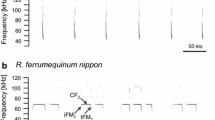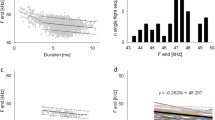Abstract
The acoustic structure of echolocation pulses emitted by Japanese pipistrellePipistrellus abramus (Temminck, 1840) bats during different phases of aerial hawking is described here for the first time. Behavioural observations of the foraging flight in conjunction with acoustical analysis of echolocation pulses indicated a flight path consisting of four distinct phases following the reconnaissance or search phase. Short (∼4.68 ms) and relatively broadband frequencymodulated (FM) pulses (∼23.55 kHz bandwidth) were emitted at a repetition rate of 15 Hz during presumed target approach. Presumed insect capture consisted of an early and a late buzz phase. Both buzz types were emitted at high repetition rates (111 Hz in early to 222 Hz in late) and consisted of very short, broadband FM pulses (1.26 ms in early to 0.3 ms in late). There was also a characteristically sharp drop in both the peak and terminal frequencies of each echolocation pulse during the transition from early to late buzz. No pulses were recorded during the final phase of foraging referred to as a “post-buzz pause”. Thus the foraging behaviour of this species consisted of five sequential phases involving four broad types of echolocation pulses.
Similar content being viewed by others
References
Bartonička T. and Řehák Z. 2005. Variability in echolocation calls ofPipistrellus pygmaeus (Chiroptera: Vespertilionidae) during search flight in different habitats. Acta Theriologica 50: 145–160.
Bartonička T., Řehák Z. and Gaisler J. 2007. Can pipistrelles,Pipistrellus pipistrellus (Schreber, 1774) andPipistrellus pygmaeus (Leach, 1825), foraging in a group, change parameters of their signals? Journal of Zoology 272: 194–201. doi: 10.1111/j.1469-7998.2006. 00255.x
Britton A. R. and Jones G. 1999. Echolocation behaviour and prey-capture success in foraging bats: laboratory and field experiments onMyotis daubentonii. The Journal of Experimental Biology 202: 1793–801.
Britton A. R. C., Jones G., Rayner J. M. V., Boonman A. and Verboom B. 1997. Flight performance, echolocation and prey capture in the pond bat,Myotis dasycneme (Chiroptera: Vespertilionidae). Journal of Zoology 241: 503–522. doi: 10.1111/j.1469-7998.1997.tb04842.x
Corbet G. B. and Hill J. E. (eds) 1992. The mammals of the Indomalayan region, a systematic review. Oxford University Press, Oxford: 1–488.
Funakoshi K. and Uchida T. A. 1978. Studies on the physiological and ecological adaptation of temperate insectivorous bats: III. Annual activity of the Japanese housedwelling bat,Pipistrellus abramus. Journal of the Faculty of Agriculture of Kyushu University 23: 95–115.
Funakoshi K. and Uchida T. A. 1982. Age composition of summer colonies in the Japanese house-dwelling bat,Pipistrellus abramus. Journal of the Faculty of Agriculture of Kyushu University 27: 55–64.
Griffin D. R., Webster F. A. and Michael C. R. 1960. The echolocation of flying insects by bats. Animal Behaviour 8: 141–154. doi: 10.1016/0003-3472(60)90022-1
Hirai T. and Kimura S. 2004. Diet composition of the common batPipistrellus abramus (Chiroptera; Vespertilionidae), revealed by fecal analysis. Japanese Journal of Ecology 54: 159–163.
Hiryu S., Hagino T., Riquimaroux H. and Watanabe Y. 2007. Echo-intensity compensation in echolocating bats (Pipistrellus abramus) during flight measured by a telemetry microphone. The Journal of the Acoustical Society of America 121: 1749–1757. doi: 10.1121/1.2431337
Huang W. J. and Huang X. 1982. The seasonal activity ofPipistrellus abramus in relation to environmental factors. Acta Zoologica Sinica 2: 143–155.
Jensen M. E., Miller L. A. and Rydell J. 2001. Detection of prey in a cluttered environment by the northern batEptesicus nilssonii. The Journal of Experimental Biology 204: 199–208.
Jones G. 1999. Scaling of echolocation call parameters in bats. The Journal of Experimental Biology 202: 3359–3367.
Jones G. 2006. Bats in China-Japanese pipistrelle. http:// www.bio.bris.ac.uk/research/bats/China%20bats/pipistrellusabramus. htm.
Jones G. and Rayner J. M. V. 1989. Foraging behavior and echolocation of wild horseshoe batsRhinolophus ferrumequinum andR. hipposideros (Chiroptera, Rhinolophidae). Behavioral Ecology and Sociobiology 25: 183–191. doi: 10.1007/BF00302917
Jones G. and van Parijs S. 1993. Bimodal echolocation in pipistrelle bats: are cryptic species present? Proceedings of the Royal Society of London B 251: 119–125. doi: 10.1098/rspb.1993.0017
Kalko E. K. V. 1994. Coupling of sound emission and wingbeat in naturally foraging European pipistrelle bats (Microchiroptera: Vespertilionidae). Folia Zoologica 43: 363–376.
Kalko E. K. V. 1995. Insect pursuit, prey capture and echolocation in pipistrelle bats (Microchiroptera). Animal Behaviour 50: 861–880. doi: 10.1016/0003-3472(95)80090-5
Kalko E. K. V. and Schnitzler H. U. 1989. The echolocation and hunting behavior of Daubenton’s bat,Myotis daubentoni. Behavioral Ecology and Sociobiology 24: 225–238. doi: 10.1007/BF00295202
Kalko E. K. V. and Schnitzler H. U. 1993. Plasticity in echolocation signals of European pipistrelle bats in search flight implications for habitat use and prey detection. Behavioral Ecology and Sociobiology 33: 415–428. doi: 10.1007/BF00170257
Ke W. Y. 1995. Reproductive cycle of the house bat,Pipistrellus abramus, in Pingtung County, southern Taiwan. Msc thesis, Tung-Hai University, Taichung, China.
Kober R. and Schinitzler H.-U. 1990. Information in sonar echoes of fluttering insects available for echolocating bats. The Journal of the Acoustical Society of America 87: 882–896. doi: 10.1121/1.398898
Koopman K. F. 1993. Order Chiroptera. [In: Mammal species of the world: a taxonomic and geographic reference. D. E. Wilson and D. M. Reeder, ed]. Smithsonian Institute Press, Washington DC: 137–241.
Lee L. L. 1995. A preliminary study on the reproductive pattern ofPipistrellus abramus in northern Taiwan. Acta Zoologica Taiwanica 6: 61–66.
Lee Y. F. and Lee L. L. 2005. Food habitats of Japanese pipistrellesPipistrellus abramus (Chiroptera: Vespertilionidae) in Northern Taiwan. Zoological Studies 44: 95–101.
Li A. A., Ren X. P., Wu F. J., Liu S. X., Wang J. Y. and Chen Q. C. 2005. Acoustic response properties of the inferior colliculus inPipistrellus abramus. Chinese Journal of Zoology 40: 6–11.
Lin L. K., Motohawa M. and Harada M. 2002. Karyological study of the house batPipistrellus abramus (Mammalia: Chiroptera) from Taiwan with comments on its taxonomic status. The Raffles Bulletin of Zoology 50: 507–510.
Lu D. J. 1988. Activity patterns of the house bat,Pipistrellus abramus, in Chu-tung. Msc thesis, National Taiwan University, Taipei, China.
Ma J., Jones G., Zhang S. Y., Shen J. X., Metzner W., Zhang L. B. and Liang B. 2003. Dietary analysis confirms that Rickett’s big-footed bat (Myotis ricketti) is a piscivore. Journal of Zoology 261: 245–248. doi: 10.1017/S095283 690300414X
Ma J., Kobayasi K., Zhang S. Y. and Metzner W. 2006a. Vocal communication in adult greater horseshoe bats,Rhinolophus ferrumequinum. The Journal of Comparative Physiology A 192: 535–550. doi: 10.1007/s00359-006-0094-9
Ma J., Liang B., Zhang S. and Metzner W. 2008. Dietary composition and echolocation call design of three sympatric insectivorous bat species from China. Ecological Research 23: 113–119. doi: 10.1007/s11284-007-0344-5
Ma J., Zhang J., Liang B., Zhang L., Zhang S. and Metzner W. 2006b. Dietary characteristics ofMyotis ricketti in Beijing, North China. Journal of Mammalogy 87: 339–344. doi: 10.1644/05-MAMM-A-183R1.1
Moss C. F. and Zagaeski M. 1994. Acoustic information available to bats using frequency-modulated sounds for the perception of insect prey. The Journal of the Acoustical Society of America 95: 2745–2756. doi: 10.1121/1. 409843
Nicholls B. and Racey P. 2006. Contrasting home-range size and spatial partitioning in cryptic and sympatric pipistrelle bats. Behavioral Ecology and Sociobiology 61: 131–142. doi: 10.1007/s00265-006-0244-7
Racey P. and Swift S. 1985. Feeding ecology ofPipistrellus pipistrellus (Chiroptera, Vespertitionidae) during pregnancy and lactation. I. Foraging behaviour. Journal of Animal Ecology 54: 205–215. doi: 10.2307/4631
Rachwald A. 1992. Habitat preference and activity of the noctule batNyctalus noctula in the Białowieża Primeval Forest. Acta Theriologica 37: 413–422.
Russ J. M. and Racey P. A. 2007. Species-specificity and individual variation in the song of male Nathusius’ pipistrelles (Pipistrellus nathusii). Behavioral Ecology and Sociobiology 61: 669–677. doi: 10.1007/s00265-006-0295-9
Russ J. M., Racey P. A. and Jones G. 1998. Intraspecific responses to distress calls of the pipistrelle bat,Pipistrellus pipistrellus. Animal Behaviour 55: 705–13. doi: 10.1006/ anbe.1997.0665
Schnitzler H.-U. and Kalko E. K. V. 1998. How echolocating bats search and find food. [In: Bat biology and conservation. T. H. Kunz and P. A. Racey, eds]. Smithsonian Institution Press, Washington, DC: 183–196.
Schnitzler H. U., Kalko E., Miller L. and Surlykke A. 1987. The echolocation and hunting behavior of the bat,Pipistrellus kuhli. The Journal of Comparative Physiology A 161: 267–274. doi: 10.1007/BF00615246
Siemers B. M., Kalko E. K. V. and Schnitzler H. U. 2001. Echolocation behavior and signal plasticity in the Neotropical batMyotis nigricans (Schinz, 1821) (Vespertilionidae): a convergent case with European species ofPipistrellus? Behavioral Ecology and Sociobiology 50: 317–328. doi: 10.1007/s002650100379
Simmons J. A., Fenton M. B. and O’Farrell M. J. 1979. Echolocation and the pursuit of prey by bats. Science 203: 16–21. doi: 10.1126/science.758674
Simmons N. B. 2005. Order Chiroptera. [In: Mammal species of the world: a taxonomic and geographic reference. D. E. Wilson and D. M. Reeder, eds]. Johns Hopkins University Press, Baltimore: 312–529.
Sum Y. W. and Menne D. 1988. Discrimination of fluttering targets by the FM-bat,Pipistrellus stenopterus. Journal of Comparative Physiology A 163: 349–354. doi: 10.1007/ BF00604010
Surlykke A., Futtrup V. and Tougaard J. 2003. Prey-capture success revealed by echolocation signals in pipistrelle bats (Pipistrellus pygmaeus). Journal of Experimental Biology 206: 93–104. doi: 10.1242/jeb.00049
Surlykke A. and Moss C. 2000. Echolocation behavior of big brown bats,Eptesicus fuscus, in the field and the laboratory. The Journal of the Acoustical Society of America 108: 2419–2429. doi: 10.1121/1.1315295
Swift S. 1980. Activity patterns of pipistrelle bats (Pipistrellus pipistrellus) in northeast Scotland. Journal of Zoology 190: 285–295. doi: 10.1111/j.1469-7998.1980.tb 01428.x
Takayama S. 1959. The chromosomes of a bat,Pipistrellus tralatitus abramus. Japanese Journal of Genetics 34: 107–110. doi: 10.1266/jjg.34.107
Uchida T. A., Mori T. and Son S. W. 1988. Delayed capacitation of sperm in the Japanese house bat,Pipistrellus abramus. Journal of the Mammalogical Society of Japan 13: 1–10.
Wang Y. X. (ed) 2003. A complete checklist of mammal species and subspecies in China: a taxonomic and geographic reference. China Forest Press, Beijing: 1–394.
Wong J. G. and Waters D. A. 2001. The synchronisation of signal emission with wingbeat during the approach phase in soprano pipistrelles (Pipistrellus pygmaeus). The Journal of Experimental Biology 204: 575–583.
Yang S. H. 1996. Activity pattern and food habits ofMyotis formosus watasei andPipistrellus abramus in Yunlin. Msc thesis, National Taiwan University, Taipei, China.
Zbinden K. 1989. Field observations on the flexibility of the acoustic behaviour of the European batNyctalus noctula (Schreber, 1774). Revue Suisse de Zoologie 96: 335–343.
Zhang J., Han N., Jones G., Lin L., Zhang J., Zhu G., Huang D. and Zhang S. 2007. A new species ofBarbastella (Chiroptera: Vespertilionidae) from North China. Journal of Mammalogy 88: 1393–1403. doi: 10.1644/07-MAMM-A-114R2.1
Zhang Y. Z. (ed) 1997. Distribution of mammalian species in China. China Forest Press, Beijing: 1–328.
Zhao N. M. 2001. Identification ofPipistrellus abramus, Miniopterus schreibersii, Hipposideros terasensis, andRhinolophus monoceros using echolocation call characters. Msc thesis, National Sun Yat-Sen University, Gaoxiong, China.
Author information
Authors and Affiliations
Corresponding author
Additional information
Associate editor was Andrzej Zalewski.
Rights and permissions
About this article
Cite this article
Ma, J., Jones, G., Zhu, GJ. et al. Echolocation behaviours of the Japanese pipistrelle batPipistrellus abramus during foraging flight. Acta Theriol 55, 315–332 (2010). https://doi.org/10.1007/BF03193235
Received:
Accepted:
Issue Date:
DOI: https://doi.org/10.1007/BF03193235




